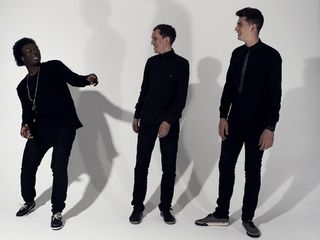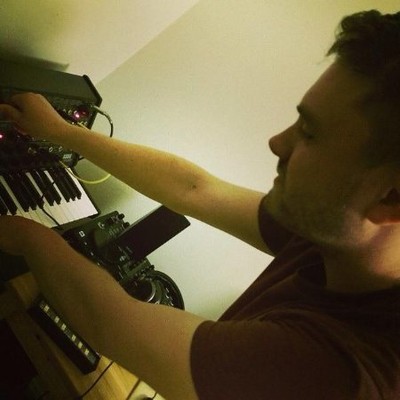
Magnetic Man: (Left to right) Benga, Artwork and Skream
2002. Dubstep is a fledgling sound emerging from the roots of UK garage, 2-step and a love of old Jamaican dubplates. At the time the genre barely exists outside of London and even within the capital it's confined to relatively small underground pockets focused around the newly formed East London club night FWD>> and pirate radio station Rinse.
Back then the heart of dubstep was Croydon record shop Big Apple Records. Employees and regular clientele included some of the genre's pioneers: Hatcha, Digital Mystikz, Loefah, Artwork, Benga and Skream.
The label that grew out of the shop's community in late '02 would go on to release some of the first proper dubstep 12-inches, including releases by all of the artists mentioned above.
Skip ahead eight years and dubstep has transformed from a small underground experiment into a huge global force in the world of electronic music. Dubstep raves are no longer exclusively underground affairs, Rinse has recently been granted a proper radio license and a handful of producers and artists stand on the verge of crossing over into the realms of proper mainstream popularity.
Leading dubstep's charge onto daytime radio playlists and main-stage festival appearances are Magnetic Man, a supergroup of sorts comprised of three alumni from the early days of Big Apple Records: Skream, Benga and Artwork.
The group's debut album drops courtesy of Columbia Records next month (a dubstep full-length on a major label = big news), so MusicRadar caught up with Artwork to chat about live gear, producing the album and how the process of making dubstep has changed since those early days.
Going Live
It may be mainstream success that's got people talking about Magnetic Man of late, but it's not just signing to a major that sets the group apart from the genre's roots. From a musical point-of-view it's the three-piece's focus on live performance, something very rare in the world of dubstep, which we find fascinating.
"A lot of what we do is about our live show," Artwork explains. "We've got three copies of Ableton Live on three MacBook Pros and they're all synced via MIDI. One's got drums, another bass and one's got the toplines. We can just set them off on their merry little way, but we're able to jump in, so you can nick a bassline or a topline from somewhere and move it around on the fly.
"On each copy of Ableton you've got the option to edit drums, bass or toplines but two of those sections are muted on each," he continues. "It means you can switch and you can make a breakdown whenever you want, which is pretty cool.
"We have a basic idea of how a set is going to play out, like any band, but then something will happen and you'll change your mind completely. You'll want to make something last a lot longer, and then completely switch it and change to another track that wasn't supposed to be in there. You'll think 'this could go off right now' and completely change it up.
"You need that, particularly when you're doing festivals sets, which are slightly different from performing in clubs. It means you can go for longer breakdowns and you can build things up for longer."
Complete control
Despite having two years of live experience under their belts, Artwork admits that they still haven't quite sorted a perfect setup for live performance. Settling on a MIDI controller is proving, it seems, a bit of a struggle.
"We've tried quite a few, but recently we've been using the Novation ReMOTE SL 61 as our Ableton controller. The problem is, you're using it and you still instinctively go back to the mousepad all the time. If something unexpected happens, you get in a panic and you instinctively go back to it.
"We've got to get ourselves more and more used to using different things, but you keep going back to that same little mousepad. It's a hard habit to break," he confesses, "but we've been getting into the [Novation] Launchpad recently, which we're going to give a try."
A Cornish getaway
Given their Ableton orientated stage setup we were surprised to learn that the album was produced in a very different setting, with a totally different set of tools. Artwork explained how the recording sessions came about:
"It was pretty weird with the timescale of what goes on in all our lives. We decided we needed to try and get away, so we hired a mansion down in Cornwall.
"We hired the house, took down an Apple Mac, a PC, a mixing desk and an Adams Audio sub. That was it basically, just stuff to get the ideas going. It was a bit intense, but we got a lot of work done for a month, then we came back and finished it off in London.
"We mostly mixed the record in Logic," he tells us, "as that's what myself and Benga use to make tunes. Although Skream has been using Fruity Loops [now FL Studio] since he was about 15, so he'd come up with some drum beats and ideas in that and fire them over to us."
Listening to the album, one of the most noticeable things is the prominence of the vocal lines on many of the tracks. It's this break away from dubstep's traditional use of shorter, sample style vocals that, in part, makes Magnetic Man's music appealing to more mainstream audiences. So how did they go about writing and producing such vocal heavy electronic music?
"We did the backing tracks down in Cornwall, and then sent the ones out that we knew we wanted vocals on, to get some rough ideas. We then went to EMI studios in London, and recorded all the vocals there.
"The guys there are just amazing; they really know what they're doing. They've got loads of great old gear; proper microphones, proper signal paths, really good compressors and they know how to use it all. So it's really nice to work with people like that."
"We did the vocals in Pro Tools so we could chop them up and get a few different stems form each. Then we took them back to ours and mixed everything."
Where were you in 2002?
Obviously, mixing in a Cornish mansion and recording vocals at EMI Studios is a world away from dubstep's Croydon born roots, and it's not lost on Artwork. His Red EP was the first release on the Big Apple label back in '02 and, as he explains, his process of making music has changed dramatically since then.
"Today you can come up with an idea, walk away from it and come back and it's all still there. I think people take all that for granted."
"That Red EP was made on a MPC, an Atari and a Nord Lead 3," he tells us. "If someone asked me to make that again now I'd have to go back and find all those old disks and all that sort of stuff, and try and get the Nord Lead sounds set right.
"Today you can come up with an idea, walk away from it and come back and it's all still there. I think people take all that for granted. Back then it was like, you made your tune when you made your tune, and that was it.
"Then there's the choice you've got today with synths and the sounds you can make, which is just phenomenal," he states, as our conversation turns to the plethora of computer-based synth options on the market today. So which of the countless software synths that have appeared since dubstep's birth stand out for him?
"Obviously Albino, that really did shift things along," he tells us; in reference to LinPlug's popular, Rob Papen designed soft synth, a piece of kit which has proved popular with dubstep producers over the years. "Some of the other Rob Papen ones too - in general that man is a genius."
"Also some of the bits of Native Instruments software that are coming out now are just fantastic," he continues. "You couldn't have imagined having synths like that back when we started. Something that powerful and that you could have that much control over."
So, eight years on from when they first started making dubstep music, what bits of kit to Magnetic Man find essential today?
"I'm really into SSL compressor plug-ins at the moment," Artwork explains. "I've got a setting for them and you just go 'whack' and you know that's the daddy. You stick that on a sound and know that it'll just bring it to exactly where you want it. It doesn't work all of the time of course, but a lot of the time it's perfect."
"That and [Native Instruments] Massive," he sums up after a moment's thought, "that's another one. I think I'd feel a bit naked without it."
Magnetic Man's self-titled debut album is out October 11 on Columbia Records.
Liked this? Then check out: Mount Kimbie on the secrets behind their debut album
Connect with MusicRadar: via Twitter, Facebook and YouTube
Get MusicRadar straight to your inbox: Sign up for the free weekly newsletter


